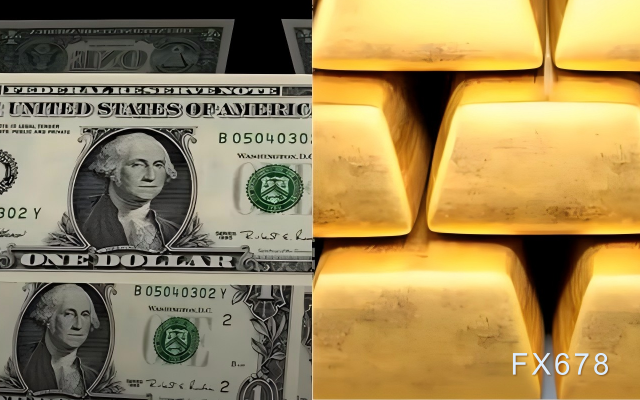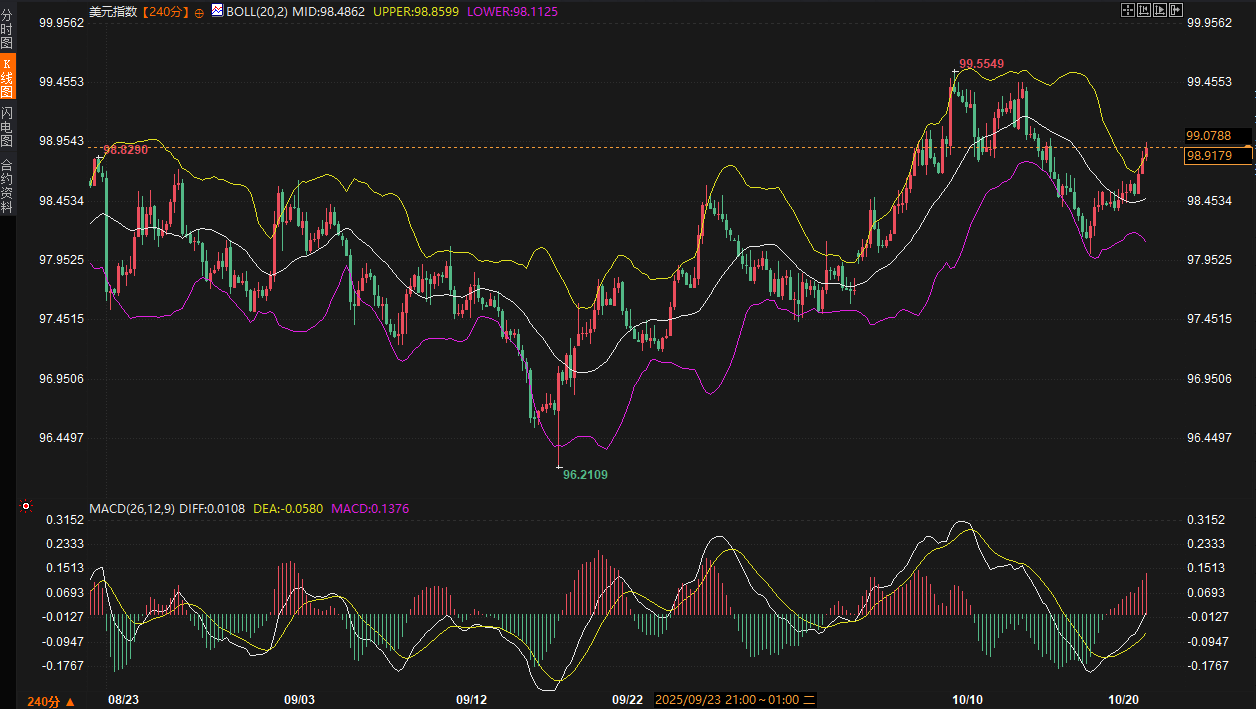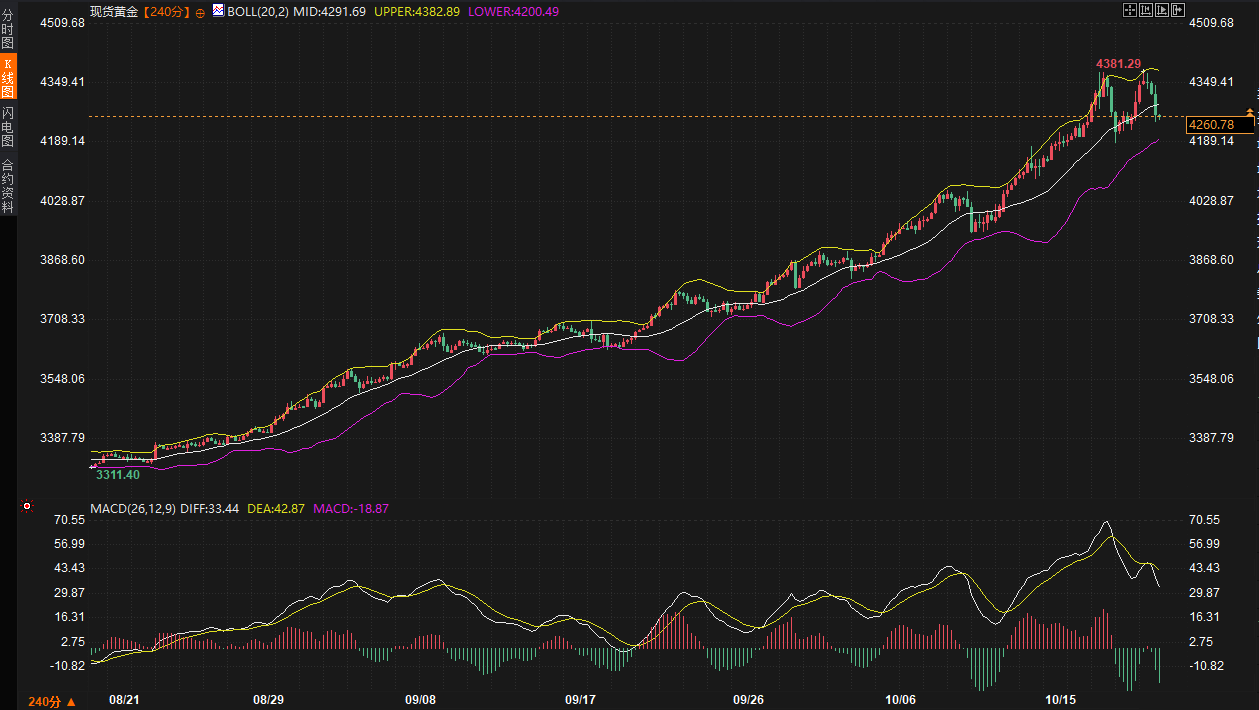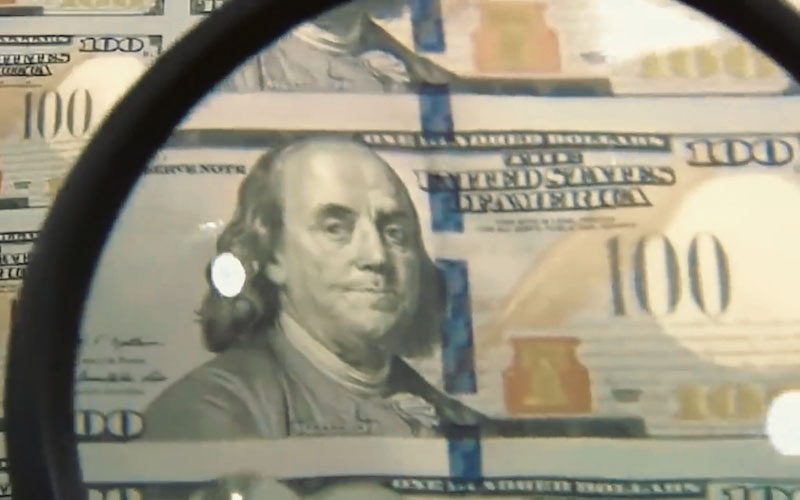Gold suddenly retreats! The US dollar surges past the 99 mark! A 20-day market shutdown triggers a data vacuum, and a decisive battle between bulls and bears is imminent!
2025-10-21 20:33:55

The Fed's policy shift is intertwined with macroeconomic pressures
From a broader macro perspective, the government shutdown, which began on October 1st, has disrupted operations across multiple sectors, including national park closures and flight delays, directly impacting the tourism industry and small businesses. Estimates suggest weekly losses to the tourism economy are estimated at $1 billion, while overall GDP could shrink by $15 billion. This cumulative effect has not only exacerbated pressure on household consumption but also blurred the release of official data—this Thursday's scheduled consumer inflation report was postponed, casting a shadow of uncertainty over the Federal Reserve's policy path. Polls show that 72% of Americans consider preserving Medicare subsidies a core issue in the shutdown impasse, with 50% blaming congressional Republicans and 42% pointing the finger at Democrats. Despite the ongoing shutdown, politicians' approval ratings have seen a slight rebound to 42%, but this has not alleviated market concerns about fiscal uncertainty.
Against this backdrop, expectations for the Federal Reserve's monetary policy have become a core driver of the dollar and gold prices. A recent survey of 117 economists by a leading research firm shows that 83 expect the Fed to cut interest rates twice this year, each by 25 basis points. This represents a significant shift from the consensus forecast of just one rate cut in the previous month's survey. Almost all 115 respondents—all 115 of them—agreed that another 25 basis point cut would be initiated at the October 29th meeting, lowering the federal funds rate to a range of 3.75%-4.00%. Only two predicted a 50 basis point increase in December. Financial market futures contracts have fully priced in this path, reflecting traders' growing belief that the Fed will prioritize addressing labor market slack. Last month, the Fed's first 25 basis point rate cut since December was driven by concerns about weakening employment data, rather than alarm over a rebound in inflation.
Federal Reserve officials, including the chairman, have repeatedly emphasized in recent statements that they will continue to monitor labor market developments. The latest private sector indicators show that layoffs and hiring remain moderate, with no signs of significant fluctuations. The median survey forecast predicts that the unemployment rate will remain stable at its current level of 4.3% until 2027, which is roughly unchanged from last month's assessment. However, concerns remain about the inflation outlook: the personal consumption expenditure price index is expected to average above the 2% target this month, and delayed official data may show that consumer inflation has risen to 3.1% from 2.9% in August. Several economists have pointed out that about half of the Fed's members are more focused on the structural imbalance between labor supply and demand, while the other half are wary of potential upside risks to inflation—particularly external factors such as risk aversion caused by tariff talk, which could push up import costs and disrupt the price chain. HSBC US economist Ryan Wang succinctly commented: "The data gaps caused by the shutdown make it more challenging for the Fed to determine whether the employment slowdown is demand- or supply-driven, which directly affects the strength of the monetary policy response."
Trump's tariff rhetoric has further exacerbated this tension. Despite the Fed's attempts to maintain its independence, ongoing external pressure has led some observers to worry about an acceleration in the path of rate cuts next year. Deutsche Bank senior economist Brett Ryan warned, "The risk of additional rate cuts next year is rising, and the Fed's independence will be tested more severely than under any previous administration." In a survey, 25 of 33 economists, or 76%, believe the biggest policy risk at this late stage of the cycle is excessive rate cuts, which could sow the seeds of resurgent inflation. Expectations for the end point of interest rates next year are even more fragmented, ranging from 2.25%-2.50% to 3.75%-4.00%, partly due to speculation about the next Fed Chair, whose term ends in May. This divergence, like an undercurrent, is quietly permeating the pricing logic of US dollar assets.
Divergence in technical signals highlights short-term speculation
Turning to the technical level, the 240-minute chart of the US Dollar Index shows signs of short-term stabilization, further confirming the support provided by the consensus on rate cuts. The current price of 98.9209 has broken away from the intraday low of 98.0073 and is approaching resistance at the previous high of 99.5549. The middle line of the Bollinger Band indicator (period 20, standard deviation 2) is at 98.4861, with the current price slightly above this line, indicating that bullish momentum has regained the upper hand after a brief pullback. The upper band of 98.8604 serves as an immediate resistance level; a break above it could test the 99.00 round number; the lower band of 98.1123 provides initial support, preventing further declines. The MACD indicator (12, 26, 9) shows the DIFF line at 0.0109 and the DEA line at -0.0579. Although both are still forming a death cross below the zero axis, the slightly positive DIFF value suggests signs of momentum recovery. Overall, the index has offset some of its previous losses since rebounding from last week's low, and the arrangement of the short-term moving average system - 50-period SMA, 100-period SMA and 200-period SMA - has become flat, reflecting the market's initial pricing of easing expectations rather than panic selling.

In stark contrast, the 240-minute gold chart shows that its 2.23% intraday drop wasn't an isolated event, but rather the product of a confluence of factors. The price, at $4259.17 per ounce, has retreated from its previous high near 4300, approaching support at its previous low of 4218. The middle Bollinger Band at 4291.62 is acting as a headwind, with the current price breaking below this line, suggesting continued bearish momentum. The upper band at 4382.92 is out of reach, while the lower band at 4200.39 looms as a potential bottom, a break of which could trigger a deeper correction. The MACD indicator's DIFF is at 33.36, and the DEA at 42.95, both above zero. However, the downward expansion of the DIFF suggests a weakening of bullish momentum, and the histogram is shrinking, signaling intensified short-term volatility. Gold's sharp drop is partly due to the government shutdown's short-term dampening of safe-haven demand. While the shutdown exacerbated uncertainty, delayed economic data tempered immediate panic, leading traders to bet that a dovish Fed approach would suppress gold's hedging premium. Furthermore, the cascading effect of the US dollar's rebound cannot be ignored—a rising index often squeezes the market for non-US assets, especially amidst a modest rebound in inflation expectations.

It's worth noting that market participants' interpretation of the shutdown has shifted from initial panic to a more rational assessment. The stability of private employment indicators, coupled with the consensus in polls on healthcare subsidies, suggests that the systemic impact of the shutdown may be contained locally. This, in turn, reinforces the Fed's "employment-first" narrative, pushing the dollar's positioning from a defensive to an offensive one. On the X platform, several experienced traders and institutional accounts shared similar observations: one macro-strategist noted that "the data vacuum caused by the shutdown has steepened the probability curve for an October rate cut, and the dollar may take advantage of this short-term rally." Another institutional observer emphasized that "gold's decline is related to the risk-off pullback triggered by tariff rhetoric, but the core issue remains the clarity of the Fed's path." While these views are fragmented, they collectively outline the market's approach to digesting the consensus on easing, avoiding overinterpreting the shutdown as a negative amplification.
Market Outlook: The tug-of-war continues under the easing path
Looking ahead, with the October 29th Federal Reserve meeting approaching, the US dollar index is expected to maintain its corrective momentum on the 240-minute chart. If the delayed release of employment data reveals stronger-than-expected labor market resilience, the index could rise further to 99.00, testing the upper Bollinger Band's potential. Conversely, if inflation indicators unexpectedly strengthen, a deepening MACD death cross could drag the index back to support at 98.00. Gold faces a more complex tug-of-war: In the short term, signs of upward weakness in the DEA line suggest further downward pressure, potentially targeting the lower band near 4200. However, if the shutdown is extended until its cumulative effects become apparent, a return of safe-haven funds could support a medium-term rebound in gold prices to the previous high of 4300. Uncertainty over next year's trajectory—particularly diverging interest rate endpoints—will continue to dominate volatility, and traders should be wary of external rhetoric amplifying risk aversion.
- Risk Warning and Disclaimer
- The market involves risk, and trading may not be suitable for all investors. This article is for reference only and does not constitute personal investment advice, nor does it take into account certain users’ specific investment objectives, financial situation, or other needs. Any investment decisions made based on this information are at your own risk.





















